The Infinite Staircase
The Celestial Staircase, a planar pathway
Ah, the Infinite Staircase, where the only thing infinite is the confusion it dishes out. You see, it doesn’t care much for your sense of direction, or old-fangled concepts like ‘up’ or ‘down’. It’s like a drunkard stumbling through the multiverse, twisting and turning every which way. You might be walking up one moment, and then suddenly, you’re hanging from the ceiling like a bat. And don’t even get me started on the gravity. It’s got a sense of humor, and it changes where you stand. One moment, you’re walking on the floor; the next, you’re walking on the wall.
How is it useful for travellers, you say? Well, I suppose the Infinite Staircase does have its perks, but you’d better be ready for a wild ride if you plan on using it. First off, it’s a shortcut like no other. You want to hop from one plane to another, or from a city on one end of the multiverse to a speck of dust on the other? The Staircase has your back, or at least it might if you can figure out where you’re going, and the riddles along the way. Now, the catch is, you’ve got to really want to get to your destination. It’s not for the wishy-washy types. You and your travel buddies need to agree on where you’re heading, and that’s the only way you’re getting there. So, if you’ve got a crew with a solid plan, this wonky contraption can save you a lot of time.
But here’s the twist. If you decide to go it alone, be prepared for a bit of a gamble. The Staircase might just drop you off at the place you desire most, which might sound great, but great is not always a good thing. You could end up in a paradise or a nightmare, and once you’re there, good luck trying to leave. It’s like the multiverse’s way of saying, “be careful what you wish for.”
The Staircase is built from a crazy menu of architecture and lighting choices. Stairs going every which way, lit by torches, lanterns, magical lights and who knows what else. It’s a construction site that never ends, but you’ll never see the builders, just hear them hammering away in the distance. Some say time elementals oversee the whole mess, but who really knows?
And if you’re into puzzles and riddles, you’re in luck. The doors are locked up tight with ’em. Oh, and there are these snake-like guardians called lillendi who watch over the place. They’re like the Hardheads of the place, but with more scales and less tolerance for nonsense.
One last thing, don’t go angering Selûne, the moon goddess. If she’s not in the mood, she might just toss you onto the Staircase for an unplanned trip – and a long one. So, be prepared for a dizzying, disorienting adventure, and remember, it’s all fun and games until you end up in a city you never want to leave.Just remember, on the Staircase, there are no guarantees, only endless stairs and infinite possibilities.
Source: Jon Winter-Holt
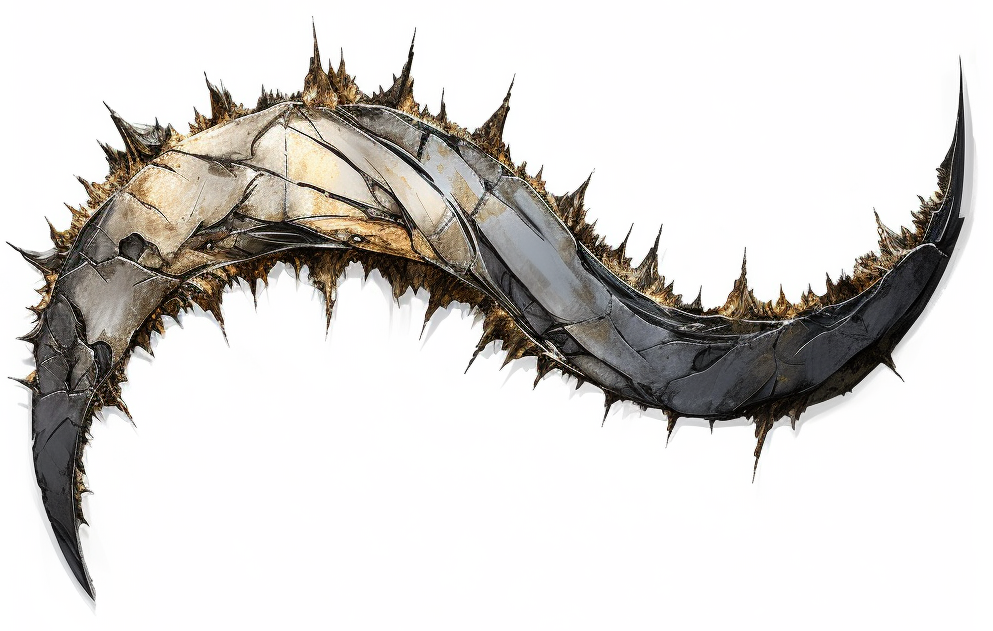
Welcome to the Steps
by Dilfar Kline, dwarven stairclimber
Listen, berk. I’ve got better things to do than bother repeating the words from some other cutter’s mouth. There’s plenty of sources of chant about the basics of climbing the endless stair [check out the references at the bottom of this post]. What I will tell you about, for the right jink, of course, are some of the pitfalls and dangers of travel on the stair. As any planar (and even most primes) knows, where there’s a way, you’d better make a will.
The lillendi are snakey women who see themselves as the guardians of the Stair, and you’d better believe they’re a sight more elegant than the chittering ratatosk of Yggdrasil! Some peery bashers have commented on their startling resemblance to marilith tanar’ri (forget to count the arms and you’d be forgiven for running a mile), but this is “apparently” a mere coincidence. Yeah, right. If you’re as paranoid as you should be on the Planes of Chaos, you’d do well to assume otherwise; I’ve heard enough rumours of beguiling lillendi spiriting off or charming unwary planewalkers — who’re never seen again — to doubt their purely good intentions. And notice how you never see a male…?
But I’m starting to rant. Don’t trust the lillendi, that’s my first piece of advice. Second is to take a stout pair of walking boots. While climbing the stair isn’t as hard on the feet as hiking up Olympus or Yggdrasil—there’s a handrail in many places, for starters—you do a lot more climbing. Other than infrequent landings, you’ll find yourself going up or down rather than along. That makes the Stair all but impractical for carrying large cargoes, because horses and even mules are hopeless with steps, and you’ll be in a real tanar’ri’s picnic if you try and lug a cart up or down ’em!
Like the other planar pathways, and unlike Sigil’s portals, the Infinite Staircase leads only to specific places on the planes. A curious prerequisite to a Stair connection is that a place must be unusually creative, imaginative, or beautiful. Nobody really knows why this is so, or even whether the Staircase only seeks places like this, or whether it’s changed normal locations merely by virtue of being connected to them. In any case it’s likely to be something to do with Selune, the mysterious power of the night who dwells in the Gates of the Moon, the foundation of the Staircase on Ysgard.
Unlike Yggdrasil and Mount Olympus, the entry points to other planes aren’t colour pools. In fact, they’re more like Sigil’s portals than colour pools, except they don’t need a key to operate, and a portal sense spell won’t do you any good. Doorways on landings and sometimes on or under the staircases themselves act as gate-portals to the plane the Stairway touches. Looking back from said plane it’s usually near impossible to find the hole in reality that leads back to the Stair. In fact, some of these doorways are one-way only.
Guides on the Stair are relatively easy to come across. The best source, of course, is the Planewalkers’ Guild itself, which has its headquarters based on a large landing on the Stair. [See Tales from the Infinite Staircase p20 for details on this organisation]. But mind you pay ’em well, because they’re valuable friends and dangerous enemies to make…
Source: mimir.net
The Corkscrew
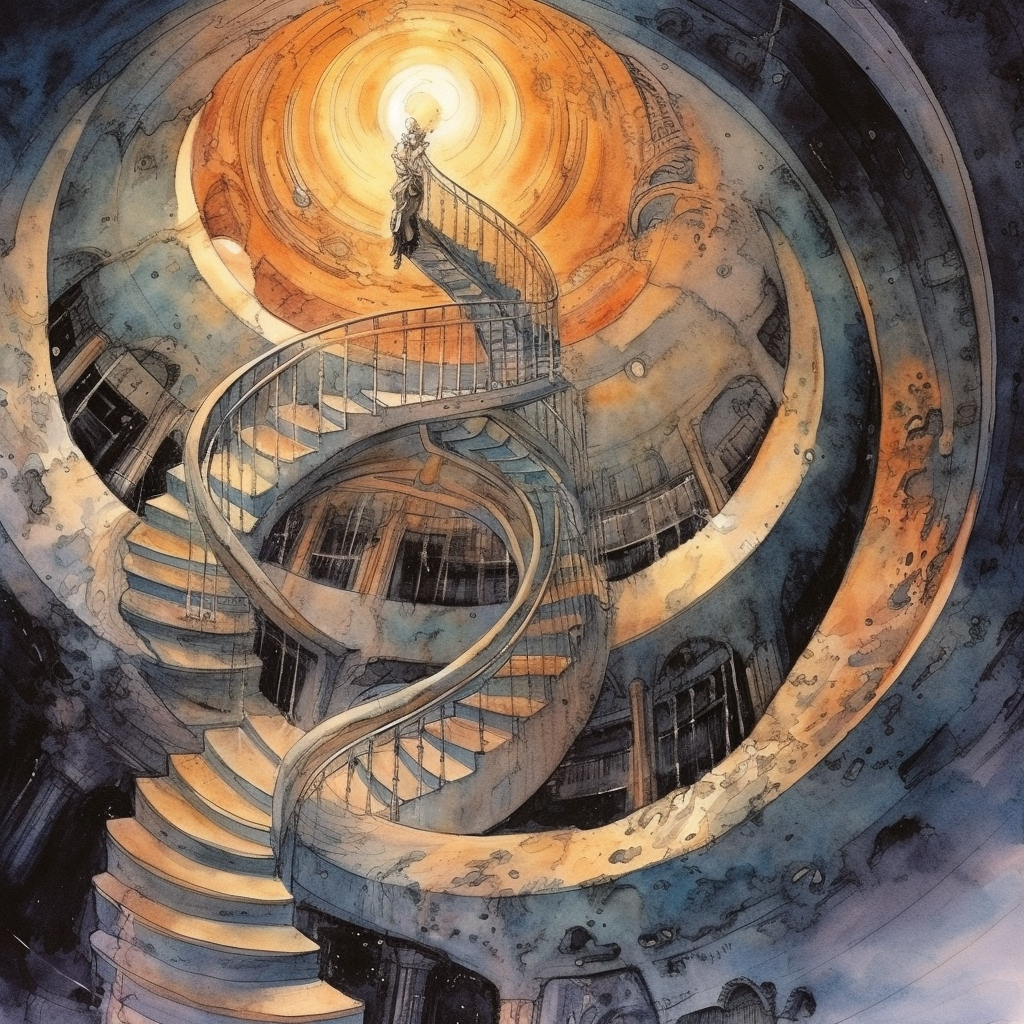
Hearsay: Everyone knows the Infinite Staircase bends and contorts along some hidden dimensions in order to fold back on itself, but usually a body can’t see that bending. Well, the Corkscrew’s different. A staircase that curls in on itself, so the rest is above you like the caverns of Pandemonium. Folks say that it ain’t natural, that it’s a sign of some problem on the Staircase. A few barmies even say that this is proof that the whole structure rearin’ to collapse in on itself, killing everyone travelling on it. But that’s barmy talk…isn’t it?
Description: One of the stranger parts of the Staircase, this length of stair, a polished, lustrous metal affair decorated with silvery inlays and accented with obsidian chips, obviously twists into a screw shape. Gravity always seems to be pointed down, but as a body moves, the direction down changes. The rest of the stairs seems to rotate around the walking person, instead of the person spinning. In a few moment, the stairclimber finds themselves directly above (below?) their previous location, which is only about forty feet away.
The effect has been compared to a rope which has been twisted too much, causing it to curl. This comparison, along with the ominous creaking of the stairs, makes many people believe something is affecting the dimensional folds of the Infinite Staircase, and that the Corkscrew is the fulcrum of that effect. If this is true, the whole Staircase is liable to snap and collapse inward, a wild maelstrom of wood, stone, and metal. Other shake their heads and argue that the stability of the Corkscrew is proof that the folds are holding and that this is simply a particularly sharply folded region. Either way, most avoid the twisting stairs.
Oddly, the Corkscrew has doors which connect directly onto the sides of the stairs, instead of onto a landing. Many of these stairs are unexplored, but those that are have been said to lead to various elemental planes (at least three door supposedly go to places in Quasielemental Lightning), along with other strange places (including, in surprising proximity, doors to the Sixth layer of Mount Celestia and the First layer of the Abyss).
Special Features: One thing making this stretch of stairs particularly treacherous is the fact that gravity is acting on a body from all directions, though not with equal strength. This means that even a small jump goes farther. The exact ration varies, but a safe estimate is that for every foot you would normally jump, you instead jump a foot and a half. This slight increase has tricked many travellers, who overshot the stairs on a sideways jump and fell into the depths of the Stairs. If a body can jump very high, they might even pass through the middle area of no gravity and fall to the other side (again, an action which risks death by missing the stairs and falling into the void). There is an upside to this, however. Those going up by foot become exhausted after 50% more time than normal, and skilled fliers [MC B or better] can manoeuvre into the very centre of the Corkscrew, where the effect of gravity is non-existent, and glide with no effort at all. In fact, incredible speeds can be achieved in this manner.
A less fantastic but nevertheless noteworthy aspect of this region is that, with a multitude of door which do not connect to landings, a body has a much high chance of meeting a variety of strange beings, from archons to tanar’ri, with a lightning mephit thrown in for good measure. Keeping this in mind (especial given the conductive nature of the stairs around lightning-based beings), this region gets more attention than most travellers like.
Source: Belarius
The Mistress of Cards
Mistress of Cards (Planar half-elf bard [she/her] / Planewalker’s Guild / CG)
A mysterious figure often seen on the Infinite Staircase, her name and history remain unknown. Her goal however is known by many, especially by those in the Planewalker’s Guild, who say when they first came to the Staircase from Sigil three hundred years ago she was already there. They tell a tale of when she first went through the gates of the Moon centuries ago, she vowed that as she travelled up the stair, she would go through every gate and portal, entertaining those on the other side, then coming back and continuing upward. Her goal is the Moon at the top of the stair, a moon not like those in the crystal spheres of the prime, but a moon of the Heavens, her ultimate goal. Though the top of the stair is her goal, she only feels she can rightfully reach it after she has gone through every door of the stair, and entertained everywhere the staircase reaches.
“She climbs on infinite stair made of cards
– Part of the Planewalker’s Ballad
Reaching towards from the gates to the moon
Singing and Dancing her way as a bard’s
The Mistress of Cards we will see soon”
She deals in all trades of the bard, from singing to juggling, though she is often said to have an affinity for cards, and thus her name. She is said to have once gone through a door and entertained Loki in his own realm, beating him at a game of cards. Her travel up the stair has lead her to many a place on the planes and crystal spheres, and she can spin a tale about any event that has happened on the planes or elsewhere. Though her travels have taken her farther up the stair then the Planewalker’s Guild’s headquarters, the guild members keep track of her progress and can tell a cutter usually where she was last seen climbing the stair.
Often when she is seen on the stair she will approach a traveller, asking if they have news of the Planewalker’s Guild, or if they care to be entertained. Entertaining is her life’s pleasure, and she enjoys showing off her talents to anyone who will watch. She also can tell a traveller the location of doors lower down on the stair, and were they lead, however in trade she expects them to tell her news of doors farther up, or maybe a tale or song. Though she is usually willing to help a someone on the stair or the other side of a door, she is always drawn back to the stair and her goal to reach it’s infinite heights.
She is described as having long red hair, a trait from her human mother, with a slender face with the slightly pointed ears of the elves. She dresses in the style of a planewalker, A multicoloured garb of blues and reds, simple leggings that hang loose and baggy, a shirt ruffled and buttoned, with a belt of twin tassels that stream behind her. Her cloak is patterned with pictures of swords, clubs, staves, and cups, with an edge a pattern of spiralling red lines. She is usually seen with no weapons, though she hides a number of daggers on her person, and she has been fabled to be master of sword, staff and club, learning their techniques over her long journey up the stair.
Source: Jeremiah Golden
Cadeon Nor
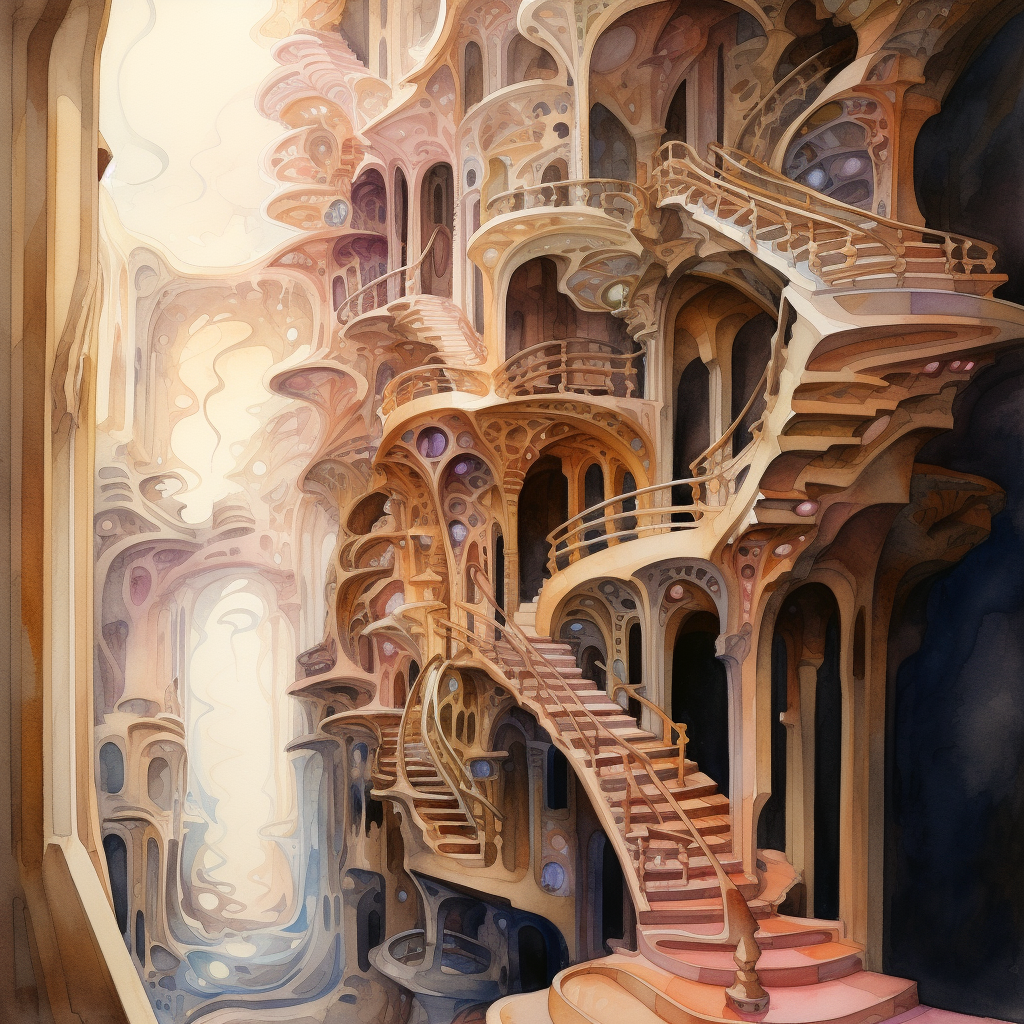
Cadeon Nor, Inventor (Prime human sage [he/him] / LN)
“If you happen to meet an old man scrawling drawings with his feet hanging off over the edge, you can be sure you’ve met old Cadeon, a prime who takes kip here on the stairs trying to tumble to the dark of how to solve his dream of flying.”
Cadeon is a prime inventor trying to build the perfect flying machine. From what prime he hails from, that’s not known. He got to the Stair one day through a portal in his study that led to the Stair. He decided that there was no better place to set up his kip than this new place (he decided against the Plane of Air because ‘on Air, man already flies, how would I test my inventions?’), as it had portals to everywhere in the Multiverse that has some sort of creativity in it… thus, there should be an infinity of like minded people to share his ideas with, his ideas of the flying man.
The old man can be found sitting on various ledges of the steps, making detailed drawings, prototypes, and models of the perfect flying machine, a machine that’ll allow human men to fly. The lillendi watch him with both amusement and admiration…. not many folks actually sit around on the staircase and draw pictures and build machines, occasionally poking through a portal to grab a bite to eat or a spare part, never giving up.
Cadeon, upon ‘finishing’ his masterpieces, always goes to the edge of his current ledge and jumps off his ledge. He hasn’t yet been successful, he always jumps off with a grin of glee, pulling levers, peddling like mad, and blowing into sails… but the best he’s ever done was crashing to a stair below without his model smashing.
It turns out that even though he constantly suffers injury at the hand of his imagination, he hasn’t ever suffered mortal injury to keep him dead. The lillendi heal him and bring him home to his kip on that little ledge of the stair whenever they find his twisted body laying sprawled on their steps, with a smashed machine nearby, and a wily, conniving grin on his face… the grin of a determined man.
While Cadeon doesn’t care much for the goings on of such things as the Planewalker’s Guild, the factions, or even folks other than the lillendi walking the Stair, he’s friendly enough to passers by, and many have been entertained (sometimes unwillingly) by detailed descriptions and explanations of his drawings and his new prototype. He always concludes these long winded speeches with a demonstration of his genius, he jumps with his machine out into the gap, yells his famous line (“Look! It works!”), plummets down to a lower level, has his machine smashed, only to be returned to his station by the lillendi to start anew… and there’s nothing in the Multiverse he loves more than starting again, the feeling that he’ll eventually stumble over that right diagram, and accomplish his goal.
Source: Tom Bubul
Famous Doorways
The Clockwork Door

This door was, originally, a circular frame which had an extensive clockwork mechanism operating inside of it. Those who walked through the machine at a precise and constant speed [specifically, a movement rate of 7] avoided harm and found themselves in the back room of one of the only human-operated inns in all of Regulus, realm of the modrons. However, since the modrons have discovered this link to an ‘unsuitably chaotic location,’ they have constructed a much more elaborate structure around the door, adding to the original gearwork.
Now encompassing a quarter of the average-sized landing it connects to, the Clockwork Door is a mammoth affair, spinning and whirring at varying speeds to keep out intruders who do not move through it in a very orderly but less easily guessed sequence. Since the modrons have effectively cut off this door from common use, it now serves as a landmark to those travelling on the stairs.
After all, it hangs over the edge of the landing far enough to be seen from a distance, makes a constant noise that can be heard from far away, and uses enough oil that those with sharp noses can even smell it before they see it!
The Liquid Archway
An open doorway to the Elemental Plane of Water, this arch looks, from the outside, to be a free-standing arch of floating water. It is by no means solid, and a body can pass their hand through it easily, but it can’t be knocked down. Also an oddity of the door is that the infinite water on the other side of the doorway never flows through onto the Staircase (in which case it would probably cause a waterfall onto the rest of the stairs).
Sharp cutters have observed that the lillendi have no control over where the staircase connects to, but that if they don’t place certain magical barriers in place, the whole staircase risks flooding with any number of liquids (not to mention poisonous gasses or snow). So, this odd free-standing and circular pond rests calmly on the edge of an otherwise dry landing, ebbing and flowing but never falling.
Byron the Watchful
Possibly the most unique of doors on the Infinite Staircase, Byron was, originally, a wizard-created creature similar to a golem, who’s duty was to watch over a specific doorway in a tower resting in Arborea. Byron, in fact, was the doorway, an arch of smooth stone with a half dozen arms (each wielding a weapon) and a gargoyle-like head. A gregarious wizard, Byron’s creator gave his creation enough intelligence to hold conversation and to interrogate those who tried to pass beneath the arch.
In time, however, Byron’s creator died, and the golem lost its purpose. When his master’s work has rotted to dust, Byron decided that there was no real need for protection anymore, and let any and all pass. Well, a band of pixies, attracted by the lingering magic of the place, set up shop and made the wizard’s tower a place of rest. They sang songs and wrote poems for their own amusement, and eventually their creativity linked the Infinite Staircase to the tower.
Byron had the wonderful luck to be the doorway.
Currently, Byron leads a double life, enjoying his new pixie friends and protecting the newly inhabited tower from intruders on the Staircase. A friendly basher, the ornate stone archway enjoys conversation with passing travellers, but one must prove their valour to Byron. This is often more difficult than one would think, because Byron’s magic allows him to see into a person’s very soul, and he permits none with cruelty in their minds to pass.
The Window
One of the discrepancies that pops up occasionally on the Staircase is ‘what is a door?’ In this case, size is the issue, and to a family of wandering avariel elves, the open window of a giant’s home is a door.
With this in mind, we can look at the case of The Window, as it is called. Living in the abandoned giant’s house, the elven family couldn’t budge the door and frankly never tried. Instead they used the shuttered windows as a doorway. Well, since that time, the house has become the centre of a small town of avariel elves, and The Window has been connected to the Infinite Staircase by the community’s creative influence. Realise, most people think two things when they see a giant window on the Stair’s landing: Either they’ve gone barmy or they’ve accidentally stepped into Xaos (which isn’t too different, really). But, travellers, the Window is a perfectly good doorway if you can fly – it’s a matter of perspective.
The Double Landing
By an odd loophole, one doorway and another on the Infinite Staircase have connected, providing a long-distance link from one part of the Staircase to another. In the one case where this peculiar phenomenon has been observed, the landings that the doors are attached to are both inhabited (one by a wizard who built is tower on a landing, the other by a bunch of primes who discovered a doorway in their basement and expanded their shop onto the Staircase).
The effect is a little disturbing, in that you can see another landing through the doorway, but not to either side, but it’s proven safe so far. Well-lanned travellers use the Double Landing to save time by skipping a few flights of stairs.
Source: Belarius
The Bytopian Tower
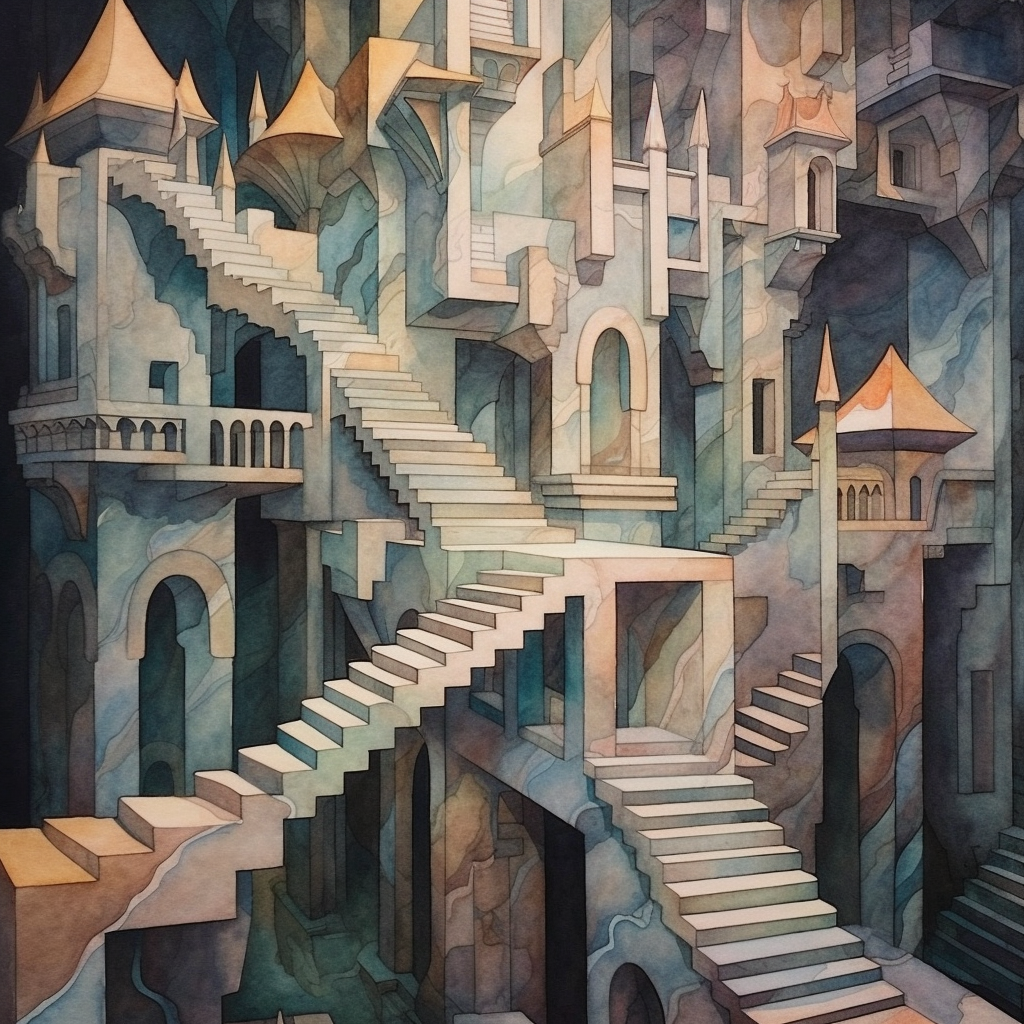
Hearsay: This story begins with a mage who wants to walk the planes. This mage, he wants to be close to the action, able to get anywhere right quick. So he says to himself one day “I don’t want to live near a portal that only goes to one place! I’ll live on the Infinite Staircase, where there’s lots of portals and don’t need to fiddle with keys and spells to find out how to use them.” And off he goes.
Well, our mage has a problem — where to live? He doesn’t want to live outside the Staircase (in case the portal disconnected or some such, stranding him), but there aren’t really houses on the stairs for sale. He can’t live with the Planewalker’s Guild, because there’s no place to put his laboratory. So he says to himself, “I’m a mage! Mages live in towers all over the place! I’ll build myself a tower right here on the stairs!”
And that’s what he does. He gets the workers and the supplies, but runs into one last problem — where to build it? So the mage looks around at the Staircase and the landings and says, “You know, towers have spiral stairs all the time. There are sturdy spiral staircases all over this sodding Infinite Staircase! I’ll just built my tower around one of them.” So he did.
He chooses a smallish one, so his tower can reach from one landing to the next. He even sets up a set of stairs running around the outside of the tower, so travellers could use the stairs without walking through his new living room. The tower’s a grand affair, build of sturdy stone and firmly fixed to both the top landing and the bottom. One day, a traveller looks at the tower and slaps his head, declaring, “That looks exactly like the CenterSpire of Bytopia!” And so it did. And thus, the mage, now long dead, built his home, the Bytopian Tower.
Description: The chant’s mostly true. The tower, some 100′ tall and as wide as 30′ (to as thin as 20′), is made of stone that matches the surrounding landings and flares out at the top and bottom, giving the impression of being a spire of Bytopia. The stairs that run along the outside complete the image. To prevent unwelcome entry, the tower has no windows (not that there’s much of a view). The original spiral staircase that now forms the spine of the tower is still in place, but is now closed off from general entry, the new stairs doing to duty of the old. A traveller at heart, the old mage even made small rooms for travellers to stop and rest in at the top and bottom — these rooms are supplied magically with food and have nothing to steal, so they are nothing but free food and shelter, essentially.
The lillendi were apparently quite annoyed originally, on the basis that the construction of the tower was impeding travel on the Staircase. They sent various threats, but got no reply. When they finally got to the scene, however, they found the Tower completed and locked up, with rooms for travellers and a new, larger stairway on the outside. They decided that the Tower was a sturdy support between the landings and that the travellers’ rooms were sufficient atonement for the previous problems. They now maintain the outside of the tower as they would any other part of the Staircase.
There are to ways to actually enter the tower proper. The first is by entering a stone dome which rests atop the original beginning of the spiral staircase. A large stone door (much like a vault door, really) rests firmly in pace, and a pendulous stone knocker is used to summon the current inhabitant. The other lies at the bottom, opposite the entrance to the travellers’ room. It, too, is a vault-like door with a stone knocker. Since the mage is dead, no one answers anymore. Thanks to impressive magic and a lack of interest, none have apparently breached either doorway in years.
Special Features: A lone traveller or small group would be advised to travel past the Bytopian Tower if they can — the travellers’ rooms provide free food and water, allowing a traveller to refill their rations before continuing on, not to mention get a good night’s sleep after hours of climbing stairs. Because of the relative infrequency of travellers who require rest (most can get to their desired location in a day or less), those who DO need it find these rooms comfortable and remarkably well provided for, consider the host is long dead.
The interior of the Tower is largely dark, but word has it that the Wizard, though well-travelled, wasn’t a great archmage so much as he had a large inheritance—as such, there is no great desire to go to the effort needed to get into the tower (which has other, more subtle wards besides your everyday wizard locks). This much is known (or strongly believed) about the interior, however:
- The mage was not a specialist, but favoured the material schools of magic (Alteration, Conjuration, and Evocation) than the more metaphysical or scholarly schools. Some argue that he was, in fact, a Dimensionalist, others that he was a Artificer, and others that he was abnormal mage. But his schools of choice were well known.
- The mage had more than a few magical constructs as servants and bodyguards (most purchased from more skilled mages). Fear of these constructs also protects the tower.
- The mage had allies on the Elemental Plane of Earth. The well-lanned say the ruvkova of that plane, specifically.
- Rich and well-travelled, the tower contains a fair number of objects which, while not strictly powerful or valuable, are odd, collectable, or otherwise curious (supposedly, these objects were collected on his travels).
- The Dark: A little truth known to a very select few is that, thought the mage is dead, he still lives in his Tower. It seems that, when he died, he became an einheriar, and, affected by his wanderlust, went on a quest to learn his past (during which he became significantly more powerful, no longer having wealth to buy his way through tough times). When he did learn who he had been, he returned to the Tower, slipped in, and now pursues research in between his frequent wanderings around the planes.
- Another unclear matter was the mage’s speciality. The truth is that he is indeed an Dimensionalist, using his extensive knowledge of the planes and magical dimensions to facilitate his travels. As such, the interior of the Tower is larger that the exterior would suggest, and is as once a palace for guests and a death-trap for thieves. The very adventurers who have made it in recently haven’t made it out yet—though some are still alive, either lost in the seemingly endless halls of the place or locked up in the dungeons.
Source: Belarius
The Monster Under the Stairs
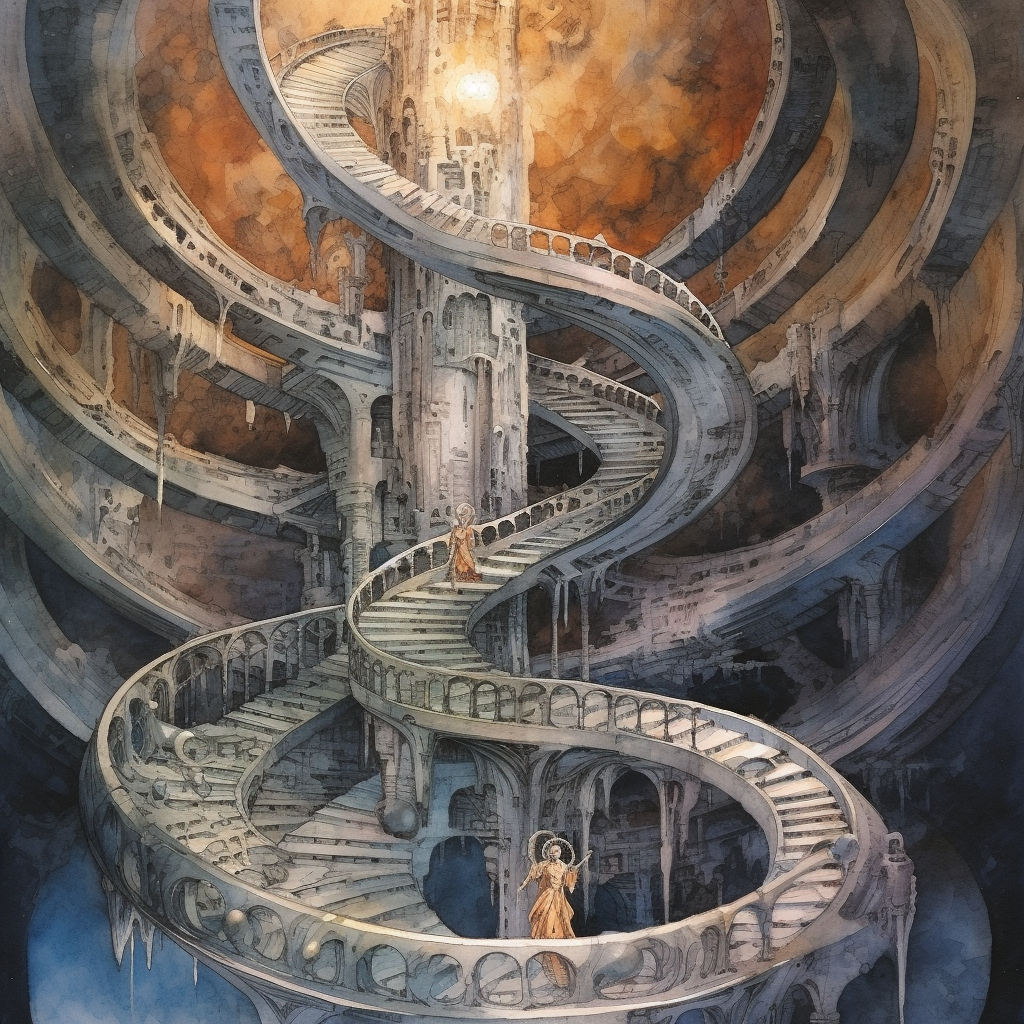
“Stick to the Styx berk, or the Oceanus, or that big mountain and that tree on the Waste… but don’t go near that infernal Staircase, or he might come. I’m telling you, he’ll drive you out of your brainbox, just look at me!
“Calm down? Fine, I’ll see if I can tell you a bit about the beast without… well, anyway, the beast. On the Staircase. Right. I’m composed now.
“I was on my way from Bedlam to, um, somewhere on Ysgard I think, I don’t remember, but anyway, and I couldn’t find a portal. Sure enough, one of those barmy snake women that live on that barmy pathway told me, ‘why not take the Staircase?’ so how could I refuse? I was barmy then, I didn’t know the danger, the danger I say! What horrors lie on that Staircase! Yes, that Staircase does cross Bedlam, we turn out some pretty bizarre artwork in that town, but I’m not going to swerve from the topic.
“I followed that lillyendo or whatever you call them and she took me to the steps. She just told me to keep walking until I saw Ysgard. But the Staircase is infinite! I could’ve walked forever! I ran and I ran and I ran but I never got anywhere, Bedlam was always right behind me! So what’s a berk to do? I just sat there, I figured ‘clear your mind man, you’re under a lot of stress’. So I sat there. And then I heard this metal thing coming down the stairs, a little spring that just walked right down towards me (the springs are seen in pairs sometimes I’ve heard), and then I saw those two eyes, those red, burning eyes, staring at me from between the boards! Ahh! I can see them looking at me! And that awful voice of his! That deep, hypnotic voice! He was calling me! So what do I do? Do I listen to myself and run? No! I walked right over to him, and now he’s in my head! He’s right here I tell you! Right between my eyes! He gave a big grin, and it seemed like he swallowed me whole! He lives! He lives in me, and in you, and under those infernal stairs! Stay clear I tell you, he’ll inhabit your mind too, and you’ll end up as my cellmate!
“He’s been seen not only by myself, but by others. He’s got snakes and bugs and critters of all sorts inside of him that bleed out when he gets cut. He wears the blackest of black and his eyes.. oh, powers, those burning red eyes.. and that grin that looks like it’s goin to swallow a sod whole! It seems he only preys on folks like me, paranoid folks afraid of the dark, noone knows where he came from or how to get rid of him, but the fact remains that he’s there, and he’s waiting! In the name of the Lady herself, don’t go on those stairs! The snake women too… they’re evil, they come from inside him. He’s they’re father. When he bleeds he bleeds snakes and bugs, but when he eats someone, he spits out a lillendi!
“I’m telling you I’ve seen it! That’s why they love people walking their barmy steps, so he can eat them! They’re hunting for food for their evil master! Why don’t you believe me? Why are you looking at me like that?”
Old Man McRacken, resident of the Irreparably Insane ward of the Gatehouse
Key Canonical Sources:
- Fiendish Codex 1 [3e] p110 (main entry)
- Tales from the Infinite Staircase [2e] whole book is an adventure set on the Staircase. Particularly useful are p10 (Staircase drawn to creativity), 14 (magical effects), 17 (lillendi), 18 (dangers flying or teleporting), 19 (encounters). Other references found on pages 4,6-29,31,34,46,57,60-61,73-74,84,86,96-97,113,117,128.
Background Reading Sources:
- Dragon Magazine #357 [3e] p70 (Infinite Staircase touches some cities of the Abyss)
- Fiendish Codex 1 [3e] p110 (main entry), 121 (Staircase in Graz’zt’s realm),151 (Staircase in Malcanthet’s realm)
- For Duty and Deity [2e] p5 (tie-in with Tales from the Infinite Staircase adventure), 13-22, 29, 50, 55-56 (parts of the adventure set on Staircase)
- Manual of the Planes [3e] p86,88 (brief intro to the Staircase)
- On Hallowed Ground [2e] p170 (Selûne and the Gates of the Moon)
- Planar Handbook [3e] p138 (brief mention)
- Planes of Chaos: Book of Chaos [2e] p116-117 (advice for travellers)
- Planewalker’s Handbook [2e] p25 (brief mention)
- TSR Jam 1999 [2e] p28-30,36 (Infinite Staircase appears in the adventure ‘the Manxome Foe’)


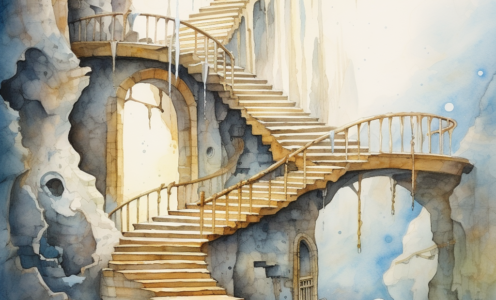
I wonder why one can’t just levitate up the Stair. That’s not very long-lasting in the case of the 2nd-level spell, but Fly from the 3rd level is. But, of course, the answer is probably that one CAN do it, and get to destinations one desires that much faster. I mean, is it the road or the destination that mattes? If going in circles or if the road ends in an abyss anyway, then all there is to do – maybe – is to enjoy the trip, but if there are real places to discover and treasures to find, that’s a different story.
P. S. Unrelated: the encyclopedia needs a separate article on petititioners. What they are, who they are, whether it is the actual person or just some projection… Is it possible to regain one’s memory, for example? To avoid merging with the plane? Curiously, it seems that in Planescape there is no real afterlife. Yet how are souls brought back with Raise Dead, then? And Resurrecton can pull them out centuries after the event. Wish can probably do it after any length of time, although Wish as a spell has limitations (which is why it was always a bad idea in the game). But a real wish – it should be possible then.
Tales From The Infinite Staircase, pg 18, actually says exactly why you can’t levitate, fly or teleport around the Staircase: you have a chance of hitting an invisible fold in space around the “outside” of the Staircase, which flings you into a random plane. This kind of makes sense: if the Staircase is a type of wormhole capable of touching all planes of existence, then the wormhole itself has to contort in unfathomable ways to touch all these planes. As a result, trying to hasten through or folding space yourself runs the risk of smacking into something you shouldn’t, namely an extradimensional bend that the Staircase seems “designed” to keep you from hitting by accident.